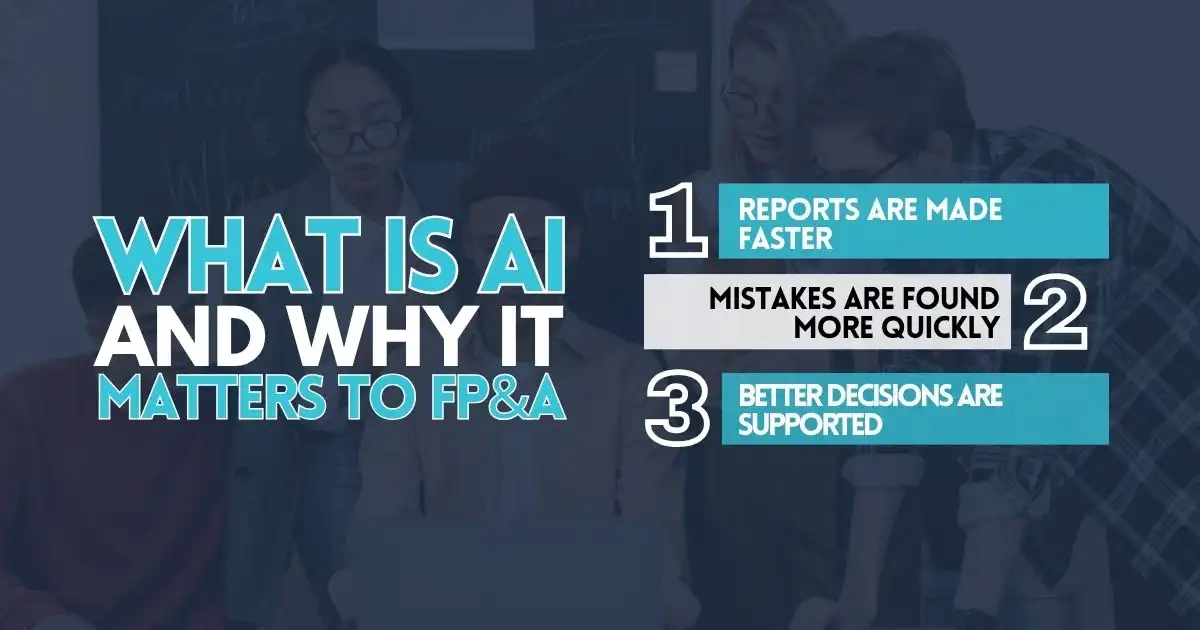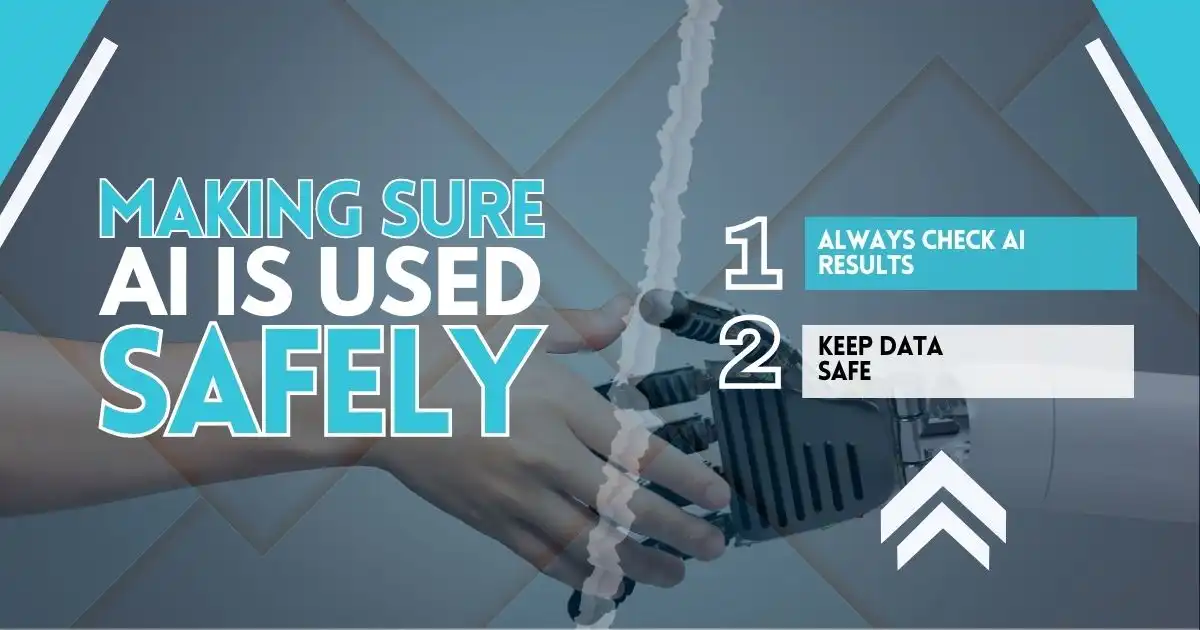Artificial intelligence (AI) is changing the way businesses work—fast. What once took hours of manual effort is now done in minutes with smart tools that learn, analyze, and adapt. In Financial Planning and Analysis (FP&A), AI isn’t just helpful—it’s a game-shifter.
It speeds up reporting, cuts down errors, and turns complex data into clear insights. Instead of wasting time on spreadsheets, teams can focus on real strategy and smarter decisions. Companies that use AI move faster and stay ahead.
The real risk isn’t using AI—it’s being left behind by those who do.
What Is AI and Why It Matters to FP&A

Artificial Intelligence is a type of computer program that can do things usually done by people. It can learn from data, answer questions, and even make predictions.
As a result, it is bringing important improvements to the way Financial Planning and Analysis teams work. By using AI, many tasks that used to take a lot of time and effort can now be completed more quickly and with greater accuracy.
This allows finance professionals to focus less on routine processes and more on thinking ahead and solving bigger problems. The use of AI is not only making daily operations smoother, but it is also helping teams to see patterns, avoid risks, and understand their data better.
Some of the ways AI is helping FP&A teams include:
- Reports are made faster, which means financial updates can be delivered on time without delays. Tasks such as collecting data, organizing numbers, and building summaries can be done in minutes instead of hours.
- Mistakes are found more quickly, since AI tools are able to scan large sets of data and point out things that look wrong or unusual. This helps reduce human error and keeps financial reports more reliable.
- Better decisions are supported, because AI can highlight trends and give insights that might not be noticed by humans alone. This leads to smarter planning and stronger business results.
By letting AI handle repetitive and time-consuming work, FP&A professionals are given more freedom to focus on strategy, forecasting, and providing advice to leadership. This shift can lead to faster growth and better financial performance for the entire organization.
The Rise of 4th-Gen AI Tools for Finance

The 4th generation of AI in finance is here—and it’s changing the game. AI tools for finance are now part of daily workflows, helping FP&A teams reduce risks, work faster, and focus on strategy.
Starting Small With AI
When starting with AI, it is often best to begin with just one small and simple task. This approach helps teams to get comfortable with the tool and understand how it works in real situations.
By focusing on a single area, the results can be measured more clearly, and confidence in using AI can be built over time. It is not necessary to change everything at once—small steps can lead to big progress.
Some examples of easy starting points for FP&A teams include:
- Creating budget reports, where AI can help gather data, format tables, and highlight key changes automatically.
- Checking for errors in spreadsheets, allowing AI to quickly spot missing numbers, duplicated entries, or mismatched figures.
- Summarizing financial results, which can turn complex data into simple and clear explanations suitable for presentations or email updates.
Once success is experienced in one area, other tasks can also be explored. Over time, more processes can be handed over to AI, leading to greater efficiency and smarter use of team resources.
Chatbots Like ChatGPT
One of the easiest ways to begin using AI in FP&A work is through chat bots like ChatGPT. These tools have been designed to understand human language and respond with helpful answers.
Because they are easy to use and do not require any special training, they can be added to daily work without much effort. When a question is typed into the chatbot, a clear and useful reply is usually given within seconds.
Chatbots such as ChatGPT can assist FP&A teams in many simple but valuable ways, including:
- Writing emails, such as follow-ups, meeting invites, or status updates, using the correct tone and language.
- Making simple financial summaries, by turning spreadsheets or data tables into short written reports that are easy to read.
- Explaining terms in easy language, which helps team members or non-finance colleagues understand technical financial concepts.
By using chatbots, communication becomes faster and clearer, and time is saved on writing and explaining routine information.
Spreadsheet Assistants
Tools such as Excel Copilot are being used to make everyday spreadsheet tasks much easier for FP&A teams. These tools are powered by artificial intelligence and are designed to assist with work that normally takes a lot of time and effort.
One of the most useful features is the ability to automatically write formulas. Instead of figuring out which formula to use or how to structure it, users can simply describe what they need, and the correct formula is provided by the tool. This reduces errors and saves valuable time.
In addition to writing formulas, charts can be created quickly to show data in a way that is easier to understand. Whether trends, comparisons, or totals need to be displayed, the AI can suggest the right type of chart and build it with just a few instructions. This helps turn raw numbers into clear visual stories.
Furthermore, suggestions for improving data are also given by the tool. It can point out missing values, highlight duplicates, and recommend ways to organize the data better. By using Excel Copilot, the quality of work is improved, and more time can be spent focusing on planning and analysis rather than formatting and checking spreadsheets.
Forecasting Tools
Forecasting tools powered by artificial intelligence are now being used by many FP&A teams to improve financial planning. These tools are able to look at past data and recognize patterns that may not be obvious to the human eye. Once the patterns are identified, future outcomes can be predicted with greater accuracy.
For example, sales figures can be predicted, helping companies to prepare for busy seasons or slow periods. This allows inventory and staffing to be managed more wisely. In the same way, spending trends can be shown, making it easier to see where money is being used and where savings can be made.
With this information, better financial plans can be created. Budgets can be adjusted based on expected changes, and risks can be reduced by preparing in advance. These forecasting tools are especially useful when decisions must be made quickly, because they can process large amounts of information faster than people can.
Also, by using AI in forecasting, more confident and well-informed decisions are made possible, which helps organizations stay strong in a changing market.
Making Sure AI Is Used Safely

While AI brings many advantages to FP&A work, it must be used with care and responsibility. To protect both accuracy and privacy, certain safety steps should always be followed.
- Always Check AI Results – Even though AI is helpful, its work should still be checked. Mistakes can be made, so human review is always important.
- Keep Data Safe – All financial information must be kept private. It should be made sure that the AI tool being used follows safety rules.
What the Future Looks Like

- More Help From AI Will Be Seen – Over time, AI will do even more for FP&A teams. It may help in decision-making, risk planning, and building smart financial strategies.
- Learning as You Go – AI does not need to be perfect to be useful. It is better to start now, learn from the experience, and grow skills along the way.
Embracing AI Is a Smart First Step
Artificial Intelligence is no longer just a future concept—it is a practical tool available today. For FP&A teams, AI offers the chance to work smarter, reduce errors, and provide deeper insights without increasing workloads.
Even the smallest step toward using AI—whether through chatbots, spreadsheet assistants, or forecasting tools—can make a noticeable difference. The key is not to wait for perfection, but to begin with intention.
By starting small, building confidence, and learning continuously, FP&A professionals can lead the way in transforming how financial planning is done.
With responsible use and human oversight, AI becomes not a replacement, but a powerful partner. The sooner it is explored, the greater the long-term advantage will be.
FAQs
How can AI tools for finance help FP&A teams?
To start, AI tools for finance can automate repetitive tasks, enhance accuracy, and support faster decision-making in FP&A processes.
What is automated financial reporting and why is it important?
Building on that, automated financial reporting uses AI to generate timely, error-free reports, saving time and improving consistency.
How can tools like Excel Copilot and ChatGPT support FP&A automation?
In practice, Excel Copilot for spreadsheets and ChatGPT for finance teams streamline data analysis, formula creation, and communication tasks.
Is the safe use of AI in finance possible during financial forecasting?
Absolutely. With proper oversight, safe use of AI in finance is ensured by reviewing outputs, securing data, and using trusted tools for financial forecasting.
